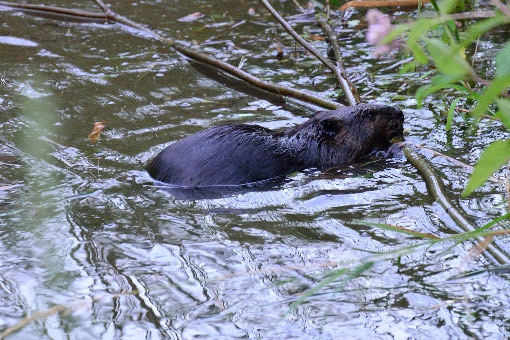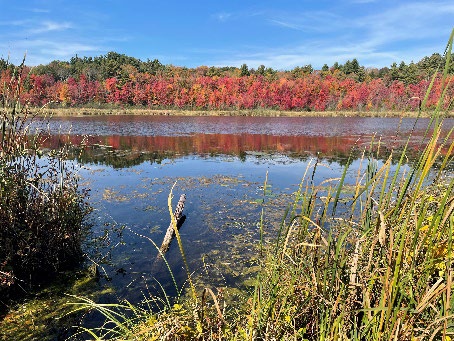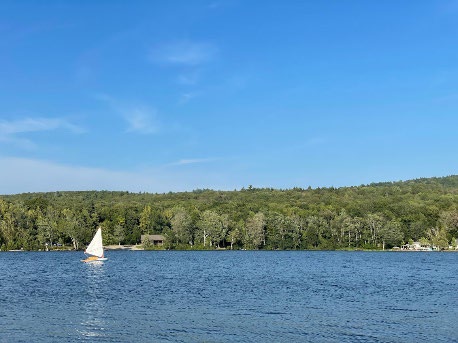Introduction
Williston lies within the 8,249 square mile Lake Champlain watershed. This watershed includes portions of Vermont, Quebec, and New York. Precipitation that falls in town eventually finds its way into Lake Champlain by one of several paths as shown on Map 12 – Watershed and Source Protection.
Land development has well-documented impacts on the volume, velocity, and quality of surface runoff. Changes in these parameters have a direct impact on the stability of a stream's channel, as well as the health of the aquatic, wetland, and riparian communities associated with the stream. These impacts have propelled Williston into a major role in watershed management.
The Town of Williston protects watershed health by:
- Managing stormwater in compliance with State permits.
- Evaluating and strengthening land use regulations to limit the impact of land development on water quality.
- Working with landowners to support good stewardship of water resources through programs like No Mow May, Raise the Blade, and the BLUE Program.
- Setting a good example by practicing low-impact management of the Town's own lands.
- Developing a plan to manage stormwater in Taft Corners more efficiently so that individual lots have more space for the highest and best uses of the land.
- Engaging neighboring towns, partner organizations and volunteers in stream restoration efforts.
- Protecting floodplains and river corridors by avoiding development within them and acquiring conservation easements.
- Enhancing public access to water resources for recreation and education, to encourage a sense of connection and investment in those resources.
- Supporting the efforts of Lake Iroquois Association and other watershed groups.
- Working with the Vermont Department of Environmental Conservation, Champlain Water District and private water suppliers to protect water quality.
Williston's Watersheds
Williston lies within the 8,249 square mile Lake Champlain watershed. This watershed includes portions of Vermont, Quebec, and New York. Runoff from the town eventually finds its way into Lake Champlain by one of several paths as shown on Map 12 – Watershed and Source Protection. Williston's watersheds are summarized below:
- The Muddy Brook runs along Williston's western border forming the boundary to South Burlington. It's 20.8 square mile watershed includes the Sucker Brook tributary and occupies approximately 9.8 square miles in Williston. The Muddy Brook watershed includes the retail centers in Taft Corners and Maple Tree Place and a portion of the industrial and commercial facilities in the north-west corner of the town. The Muddy Brook fails State water quality standards for toxins, nutrients, and temperature for the last seven miles of the tributary due to urbanization of this watershed.1Evan P. Fitzgerald, Samuel P. Parker, 2009. Muddy Brook Phase 1 and 2 Stream Geomorphic Assessment Summary. http://www.town.williston.vt.us/vertical/sites/%7BF506B13C-605B-4878-8062-87E5927E49F0%7D/uploads/%7B922450B7-536D-4114-A65A-AE44AF7AE55D%7D.PDF. Accessed December 5, 2024.
Dylan O’Leary, 2022. Williston Wildlife Corridors. https://storymaps.arcgis.com/stories/e373041378f849a496042ba134426a14. Accessed December 4, 2024.
Stormwater Management
The Town of Williston discharges stormwater under the authority of a Small Municipal Separate Storm Sewer System (MS4) General Permit issued by the State of Vermont Agency of Natural Resources. As a condition of the permit, the Town is required to develop a Stormwater Management Plan3Town of Williston Stormwater Management Program. Accessed 4/15/2025 at https://www.town.williston.vt.us/vertical/Sites/%7BF506B13C-605B-4878-8062-87E5927E49F0%7D/uploads/FOR_SUBMITTAL_Williston_SWMP_Update_2024_V2.pdf
carrying potential pollutants to receiving surface waters. Potential pollution sources may include runoff from agricultural fields, erosion run-off, residential areas where excessive lawn treatment chemicals or fertilizers are applied, parking lots where vehicles may have leaked fluids and where salts are often applied during winter months, or construction sites where large areas of disturbances are common. Each of these potential pollutant sources needs to be identified and mitigated to minimize their potential for commingling with stormwater runoff and eventually entering our waterways.
When receiving waters do not meet their intended use due to a specific pollutant(s), additional standards for the Stormwater Discharges to that water body become required. In the Town of Williston, our stormwater is received by seven surface water bodies which include the Allen Brook, Johnnie Brook, Lake Iroquois, Muddy Brook, Shelburne Pond, Sucker Brook, and the Winooski River. Of these seven waterbodies Allen Brook, Muddy Brook, and Lake Iroquois are listed as impaired by the State of Vermont, but only the Allen Brook has discharge restrictions at this time. Muddy Brook and Lake Iroquois are being monitored as local cleanup efforts continue. Under the MS4 permit the Town of Williston is required to implement a Stormwater Flow Restoration Plan4Dubois & King, Inc. Town of Williston Allen Brook Flow Restoration Plan. Accessed 4/15/2025 at https://www.town.williston.vt.us/vertical/Sites/%7BF506B13C-605B-4878-8062-87E5927E49F0%7D/uploads/Allen_Brook_Flow_Restoration_Plan.pdf
Stormwater Management in Taft Corners
The Taft Corners Vision Plan noted stormwater management as an overarching issue that will affect how the area is developed. The Vision Plan stated, "The current practice of pushing storm-water management entirely onto individual lot owners is a guarantee of a smaller tax base and a bigger environmental footprint. It ultimately forces an automobile-dependent environment." Rather, stormwater management should be handled collectively like water or sewer, either as a Town utility or via a shared responsibility among landowners.5Town of Williston, 2021. Taft Corners, Williston, Vermont: Vision Plan Created by the Residents of Williston. Accessed on 4/15/2025 at https://www.town.williston.vt.us/vertical/sites/%7BF506B13C-605B-4878-8062-87E5927E49F0%7D/uploads/Taft_Corners_Vision_Plan.pdf.
Stewardship
While State and Federal government entities are ultimately responsible for protecting our local waterways, the Town of Williston will strive to keep those waterways free and clear of contamination. Quality of life is linked to a healthy environment. In recognizing this mainstay, the town will strive to become a sustainable community of citizens and businesses motivated to conserve and enhance natural resources through policies, programs, and outreach activities.
The Town can support stewardship of our waterways by taking the lead and practicing good stewardship of its own lands. Such practices include minimizing mowing where feasible and, where mowing must occur, raising the level of the mower blades to 3 inches; restoring wetlands where feasible, and replacing mowed grass with native vegetation that slows runoff and promotes infiltration.
The Town can also encourage good stewardship through promotion of programs like No Mow May6Plantlife. No Mow May. Accessed 4/15/2025 at https://www.plantlife.org.uk/campaigns/nomowmay/.
Lawn to Lake. Raise the Blade program. Accessed 4/15/2025 at https://lawntolake.wpengine.com/?page_id=13.
BLUE Williston. Sea Grant Lake Champlain. Accessed on 3/24/2025 at https://www.uvm.edu/seagrant/blue/blue-williston
Stream Restoration
Efforts to restore Williston's named streams began in 2001 with the Sucker Brook stream stabilization project. In the mid-1980s, a high flow event re-routed Sucker Brook out of its channel, away from a 25-ft waterfall, through an abandoned sand and gravel pit traversing exposed sand, silts, and clays. Over the next twenty years, the channel steadily eroded. Approximately 72,000 cubic yards of material were transported downstream, leaving a steep, unstable channel at the bottom of a 40-ft gully.9Dubois & King, Inc. website. Sucker Brook Channel Stabilization and Natural Channel Design. Williston, Vermont. Accessed 4/15/2025 at https://www.dubois-king.com/projects/sucker-brook-channel-stabilization-and-natural-channel-design/.
Acquisitions or conservation easements on high priority parcels permanently protected 37 acres of land along the Allen Brook and its tributaries, and 18 acres within stream buffers were planted with native trees and shrubs. Steep and highly erodible stream banks were strategically cut back and gradually sloped in many locations, resulting in the removal of 228 cubic yards of sediment.10Stream Buffer Restoration. Town of Williston website. Accessed 4/15/2025 at https://www.town.williston.vt.us/index.asp?Type=B_BASIC&SEC={5E27EA55-FB4C-4420-9162-64DC7BF93780}.
Flood Resilience
The Town of Williston has developed strategies to build flood resilience. This includes identifying areas vulnerable to flooding or fluvial erosion; designating those areas to be protected to mitigate risks to public safety, critical infrastructure, historic structures, and municipal investments; locating new development in safer areas; using sound stormwater management techniques to reduce flooding; conserving floodplains and upland forested areas that attenuate flooding; and encouraging flood emergency preparedness and response planning (see Chapter 12 – Hazard Mitigation). The town will continue to implement these strategies.
Williston's regulations include "watershed protection buffers" for all streams, ponds, lakes and for certain wetlands. These include:
- A shoreline buffer of at least 150 feet for all ponds and lakes exceeding an area of a half-acre;
- A shoreline buffer of 250 feet for Lake Iroquois;
- A buffer of at least 150 feet for the Allen Brook, Muddy Brook, Sucker Brook and Winooski River;
- A 50-foot buffer for all unnamed streams;
- A 50-foot buffer around all Class 2 Wetlands and certain Class 3 Wetlands, and
- Special Flood Hazard Areas
The town's regulations stipulate that land within these buffers shall remain undeveloped and in native vegetation. In total, the watershed protection areas generally provide greater protection than the statewide River Corridors under the jurisdiction of Vermont Agency of Natural Resources, and very little land area is within the River Corridors that are not already under the town's watershed protection buffers (see Map 12 – Watershed and Source Protection). Nonetheless, to assure consistency with State statute and with surrounding towns, the town should consider incorporating the ANR River Corridors into the flood hazard protection standards in the Bylaw. Similar to the Special Flood Hazard Areas, the River Corridors should become part of the watershed protection buffers listed above.
Stormwater management techniques can also help to slow the spread of floodwater. It should be noted that stormwater treatment standards required under Vermont law are designed to capture 90% of the annual storm events and to safely "pass" a 100-year storm event, meaning that even well-designed stormwater infrastructure won't prevent flooding in an extreme event.
Lake Iroquois
Lake Iroquois is a 229-acre kettle pond that lies in the Lake Champlain watershed and is bounded by the towns of Williston, Richmond, St. George and Hinesburg. The lake was formed after the last ice coverage in Vermont receded about 15,000 years ago. Over the years, the lake has naturally become more eutrophic, and it has been the site of significant human development and use in the last 150 years. By 1900, settlers had cleared most of the Lake's watershed for farming and began to build seasonal camps on its shores. A hundred years later, much of the watershed is reforested but most of the shoreline has been developed with over 90 summer camps and year-round homes.
A dam built on the lake's outlet in the mid-1800s was used to control the water supply to mills downstream in Hinesburg. Milling declined in the 20th century and in the 1960s the dam was intentionally cemented in its top position, keeping the pond at its current level throughout the year. Approximately 32 streams flow into the lake on the north, east and west sides, the largest flowing in from the northwest (crossing Beebe Lane). There are also several streams that bubble up from the lake bottom.
The lake is used extensively throughout the year by residents and by visitors. The Lake Iroquois Recreation District (LIRD) maintains the public beach at the north end of the lake. The LIRD also maintains a trail network on the land around the lake. The trails are accessible from the beach parking lot. The Vermont Fish & Wildlife Department maintains the fishing access and boat ramp, also at the north end of the lake, which provides public access to the lake for boating and fishing.¹¹
The Vermont Agency of Natural Resources has classified Lake Iroquois as eutrophic, meaning that the Lake's waters are rich in nutrients (i.e. phosphorous, nitrogen) that promote the proliferation of plant life, especially algae, which in turn reduces the dissolved oxygen content that fish and other aquatic species rely on for survival. The elevated nutrient levels in the Lake have also contributed to the spread of the invasive aquatic plant, Eurasian Watermilfoil (Myriophyllum spicatum). Since 1979, studies have indicated that Lake Iroquois has one of the highest average levels of phosphorus of all lakes in the State.¹²
The Lake Iroquois Association (LIA) is a 501(c)(3) non-profit corporation whose sole purpose is to maintain and enhance the Lake Iroquois ecosystem. The LIA aims to encourage and guide appropriate public uses of the lake and its watershed for the purpose of protecting and preserving the lake's overall well-being. These goals are achieved through monitoring, preventive and management initiatives, research, education, advocacy and other actions, involving the cooperative efforts of property owners, Town, State and Federal officials, and other interested parties.¹³
The LIA's efforts are paying off. In 2022 the Vermont DEC granted the Lake Iroquois Association the "Gold Lake Wise Award"¹⁴ to recognize that 15% of the properties surrounding the lake follow shoreland best management practices and have received an individual Lake Wise Award¹⁵ for their efforts. The town should support the efforts of the LIA through direct funding and in-kind contributions, to help them achieve their mission to restore the lake.
Source Water Protection
Williston residents and businesses receive their drinking water from one of three sources: a private well, which is managed by the landowner; the Lake Iroquois Source Protection Area, which is supplied by the Champlain Water District (CWD); or the Porterwood Source Protection Area, which is supplied by the Williston Fire District #1 (FD1). Williston's two Source Protection Areas (SPAs) are shown on Map 12. Water suppliers who manage SPAs are responsible for developing and updating Source Protection Plans (SPPs), which are designed to maintain the integrity of the SPA. These Plans must comply with State and Federal Rules governing water supply protection. This chapter calls for Williston to ensure that all development activities within the designated SPAs are consistent with the SPPs; therefore, development proposals within SPAs will be referred to their water suppliers for comment prior to the issuance of a permit.
Groundwater Protection
Groundwater in Williston is protected under the jurisdiction of the Vermont Department of Environmental Conservation Drinking Water and Groundwater Protection Division. The Regional Office Program issues water/wastewater permits (WW Permits) for soil-based wastewater systems with flows of less than 6500 gallons per day, for potable water supplies (water supplies that are not public water supplies), and for municipal water and sewer connections. The Vermont Wastewater System and Potable Water Supply Rules (adopted June 30, 2007) supersede existing municipal ordinances and zoning bylaws that regulate potable water supplies and wastewater systems. Municipalities may continue to have ordinances and/or bylaws that: (1) only regulate the use and/or operation of municipally owned water and/or sewage treatment plants; (2) require submission of copies of plans and documents used to obtain a state permit under these Rules to the municipality; (3) require a certificate of occupancy that is based on full compliance with a state permit issued under these Rules; (4) require notice of, and have the option to observe, any soil testing such as the digging of test pits; and (5) require time of sale inspections. In light of its limited authority to regulate water supplies and wastewater systems, Williston will work with the Vermont Department of Environmental Conservation to further the goals of protecting groundwater quality and quantity.


